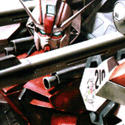|
I'm really confused what you are trying to say, Polyakov. I'm saying that it's irrelevant to look for 'the origin of the story', Persepolis is a first hand account where the author claims to have seen the keys and been told about their meaning in person, being in Iran at the time of the war. That cartoon is a primary source, and it's really not figurative.
Fangz fucked around with this message at 15:25 on Feb 4, 2017 |
|
|
|

|
| # ? May 10, 2024 04:15 |
|
I shouldnt post shortly after waking up i have been gibbering quite badly. I initially didnt know that the cartoon in question was a primary source, i assumed it was a newspaper strip from the time, a political cartoon rather than from a book meant as a historical record hence my comment about a figurative nature, so i was asking where it had come from based on that assumption. I wasnt aware of Persepolis' existance at all, it may well be accurate, though if it was widespread i would really expect to see some photographic evidence of some kind probably recovered from Iraq, it may well exist but i havent found it yet. The other thing i was talking about was in looking around myself seperate to that cartoon for where the origin of the story might have come from, the first instance i found of the thing being mentioned was in a national review article published in 1984. There was seperately a book written by an NYT reporter called Persian mirrors which talks about iranian soldiers wearing keys on their uniforms which was written by a long term Iranian expert reporter. I wasnt trying to argue against the strip at the time because i didnt know what its origin was.
|
|
|
|
Cyrano4747 posted:It's a bit much to call that a comic strip. Random fact: Art Spiegelman, who wrote Maus, is the inventor of Garbage Pail Kids.
|
|
|
|
Phanatic posted:Random fact: Art Spiegelman, who wrote Maus, is the inventor of Garbage Pail Kids. Haha...thanks, my brain is now on fire
|
|
|
|
If you look at the Wiki entries for Plastic keys to paradise (linked from https://en.wikipedia.org/wiki/Plastic_Keys_to_Paradise) it's kinda remarkable that the only linked sources in the Arabic and Farsi versions are the ones from the English page. There's a link to an alleged picture of the "keys" in question on a militaria forum, and the things in that unverifiable pic don't look like gold-painted plastic door keys. They're dog tags with writing and pictures on them. According to google translate the Farsi and Arabic Wiki entries are calling bullshit. I only did about 30 seconds of research and I'm not a scientist but if you for some godforsaken reason asked me for my opinion I'd voice doubt at this point.
|
|
|
|
Well, the historicity of it is obviously enormously political inside and outside of Iran.
|
|
|
|
Acebuckeye13 posted:Maybe, maybe not... though I don't believe they've ever been confirmed to be a widespread thing, they're definitely mentioned in the memoir/graphic novel Persepolis: Material like this is why I felt the need to say the story is "unverified" rather than false, although I myself do not believe it. Conservative Muslims usually disapprove of men wearing gold jewelry, even gold plated or painted, which makes me suspicious when Mullah's are supposedly handing out such charms. It is such a tempting tale, and very visual. Persepolis is a great novel and one I'd recommend to everyone, especially those interested in Iranian history and culture. However I think this quote is a good example of the sort of historical reference you need to handle carefully. Note that in this passage Satrapi doesn't claim to have seen the keys distributed herself, nor is she even talking to someone who has. This isn't a first hand account, it is third hand, and it was recorded in comic form many years after the events occurred. Maybe this happened exactly as she wrote, but maybe her friend just recounted the story of keys being distributed to children and an actual key was inserted because it made for a better panel. There was a great contemporary interview I read last summer with a member of the Pasadran captured in Iraq (I can't find it again unfortunately) whose story was rather different from the conventional narrative. He enlisted illegally while underage, much to the chagrin of his parents. When asked why he didn't say anything about religion, his Mullah and teachers had encouraged him to participate but were pointed about only doing it when of legal age. Instead he attributed his decision to much more familiar notions of patriotism and self defense and his own impatience for adventure/glory. He recalled being sent home from the recruiting office the first time he tried and when he tried again the office was filled with a mob of other young boy-men so eager to join they were practically ready to lynch the officer if they were prevented.
|
|
|
|
Talking about the keys to heaven, it always surprises me how quickly our knowledge of historical events fade. I was alive when that war was going on, there were video cameras and computers and most people who were involved are still alive. It's not ancient history that we're reading about on papyrus or something. But we still can't verify whether this pretty major detail was a myth or not.
|
|
|
|
teething rings already have plastic keys on them, so do some playsets for very young children, you wouldn't even need to make any new factory equipment, just paint them gold
|
|
|
|
Also it's entirely possible one cleric somewhere did this off his own bat with a quick trip to Toys'r'Us and Michaels and it got blown up and misreported as some official omnipresent thing.
|
|
|
|
Iraq related, there are some neat exhibits in the National Infantry Museum: Saddam's sword and shotgun:    
|
|
|
|
drat he would had made a pretty epic Final Boss
|
|
|
|
Maybe we're still fighting his final form.
|
|
|
|
Perhaps he could fight Patton, who would be wielding the saber he designed while wearing his sweatshirt? Japanese machine gun with bayonet:  Also, Dark Helmet was apparently a member of the Fedayeen: 
|
|
|
|
I decided to try my hand at some effort posts. Some of you probably know a lot more about the historical details, so please correct me! Although Sweden does have naval victories in its history, the three ships I'm going to cover all met horrible, violent, and/or humiliating ends. Part 1 - Mars Makalös Part 2 - Vasa Part 3 - Kronan Part 4 - Appendix: Vasa in Modern Times Three Dead Swedish Ships: Part 1 - Mars Makalös The name of the ship is a bit confusing - it was apparently known both as Mars and Makalös ("without peer" or "unmatched"). A TV documentary I saw called it Mars Makalös which sounds the most formal and coolest in Swedish, but I'll use Mars for brevity.  Jacob Hägg, 1909 - this picture is probably not terribly accurate Background  Erik XIV When Erik XIV became king in 1561 he inherited a newly-minted heriditary monarchy created by his father, Gustav Vasa (considered the "father of the nation"). Erik was very interested in gaining control of the lucrative Baltic trading routes, but to do so he had to go up against two other dominant Baltic powers - the Hansa guild (specifically Lübeck) and Sweden's #1 favorite enemy, Denmark.  Sweden 1561 Lübeck during this time had more or less a monopoly on Baltic trade, but a crack appeared when Reval and its surrounding areas (now Tallinn in modern Estonia, highlighted in the above map) asked to be placed under Swedish protection. This gave Sweden a foothold on the eastern Baltic shore. (My understanding is that modern day Finland was a complete backwater at this point)  Pictured - Finland in the late 1500s (Eero Järnefelt, 1893) Denmark (also ruled by a young monarch itching for conflict, Frederick II) was Not Pleased with this development since he also had his eye on Reval. Some other petty shenanigans occurred (Erik was miffed that Denmark incorporated the Swedish Three Crown design in the Danish coat of arms) and it was time for another war: The Northern Seven Years' War. Ship Details  A modern rendering of Mars Ship-to-ship combat during this era was predominately carried out by hooking another ship, boarding it, and engaging in hand-to-hand combat. Cannons certainly existed, but nobody had made them the primary offense for a ship - until Mars. Construction of Mars started in 1561 and was complete in 1563. Mars was a big sunnuvabitch - around 1800 tonnes displacement, 60-70 meters long, 13-14 meters wide, with a crew of around 600-700 men. This was the largest ship in the Baltic when constructed and one of (if not the) largest ships in the world when it was constructed. It's actually larger than Vasa, the next ship we'll cover. Sources differ on the armament, but it had either 107 or 173 cannons of various sizes. Unlike the later Vasa and Kronan, Mars wasn't a particularly decorated ship. This was a no-nonsense battleship dedicated to one purpose - smashing the enemy (yet another name for the ship was Jutehataren - "Danish Hater" First (and Final) Battle The war encompassed many battles on land and sea, but the particular one we care about is The First Battle of Öland that took place on May 30 - 31, 1564.  The battle took place just north of Öland The Swedish fleet was led by Admiral Jakob Bagge. Under his command were around 35 vessels of various sizes with around 5200 men (a mix of sailors and soldiers). Bagge naturally chose Mars as his flagship. Some other large Swedish ships include Elefanten and Finska Svanen. Opposing him was an Allied fleet of Danish and Lübecker ships which also totaled around 35 ships with about 6600 men. The Lübeckers were led by Friedrich Knebel on der Engel and the overall command was given to the Dane Herluf Trolle on the Fortuna. The Swedish fleet sighted the enemy on the morning of the 30th. The fleets sailed to meet each other off the north coast of Öland and made contact around midday. The first day went swimmingly for the Swedes. The Danish flagship Fortuna was heavily damaged in the battle and would require extensive repair at sea for both the remainder of the day and well into the night. The fearsome firepower of Mars managed to damage the Lübeck ship Lange Bark badly enough that it sank along with the sun. Supposedly this was the first time in history that a ship was sunk by cannon fire from an enemy ship! Fighting broke off when the sun went down and Swedes were feeling pretty good about themselves. When the sun rose on the morning of the 31st, Bagge again ordered the Swedish fleet to engage. However, the Swedish fleet had been blown around quite a bit overnight, and only six other ships were close enough to Mars to join the battle. Bagge still felt confident since Mars was by far the most imposing ship in both fleets. The Swedish strategy was to rely on the superior firepower of Mars as much as possible and not let the Allied ships get close enough to engage in man-to-man combat. The effective range of artillery during this age was only around 100-200 meters. The larger cannons could reach out to about 1500 meters max, but the accuracy dropped off considerably due to crude sights, lacking technique, uneven powder quality, and cannon quality. At around 5 in the morning, Mars, Elefanten, and Finska Svan opened fire on the Allied fleet. Bagge attempted to drive the enemy fleet close to the coast and trap them, but the Lübeckers saw the trap and retreated. Towards evening the winds changed dramatically, trapping the Swedes in a stand-still in a bad position relative to the Allied fleet. Knebel's der Engel and another Lübecker ship der Fuchs managed to get close enough to one side of Mars to engage in a furious close-quarters battle. The Danish fleet attempted to get close to the other side, but viscous fire from the three big Swedish ships forced them to withdraw. Fortuna was again heavily damaged by the bombardment along with another Danish ship. After a long battle of exchanging gunfire, the Swedish Elefanten and Finska Svan eventually managed to get some wind in their sails and withdrew from the battle along with the rest of the Swedish fleet... except Mars. Alone and heavily outnumbered, Mars was hooked by the Danish Byens Løffue on the other side. It was now sandwiched between two enemy ships, nullifying its artillery advantage. A furious old-school ship battle took place with the Danes and Lübeckers attempting to board Mars several times and being repulsed in intense man-to-man combat. Mars was showered with caltrops and lances and peppered at point-blank range with incendiary shot. Mars eventually caught on fire and a powder barrel exploded, causing an inferno to erupt below decks. The fire quickly became unmanageable and the crew pleaded with Bagge to surrender. The smoke and fire were so bad that it was impossible to stay below decks. Bagge surrendered and was taken prisoner, being transferred to another ship. The remaining crew was also slowly being transferred off Mars, while at the same time 300-400 Lübeckers were sent onboard to attempt to take control of the badly damaged prize. They didn't get very far, because shortly thereafter Mars violently exploded and quickly sank. With her went the 500-600 remaining Swedish crew along with the 300-400 raiders; in other words, around 800 - 1000 people total.  Hans Bohrdt, Sieg der Lübecker Aftermath Both the Swedish and Allied fleets slunk away after the loss of Mars. The Allied fleet in particular was in dire need of repair. Jacob Bagge was held prisoner for the remainder of the war, only being released in a prisoner swap in 1571. The loss of Mars and the imprisonment of Admiral Bagge was obviously a big blow to Sweden. The larger war didn't go so hot either. Although Sweden managed to repulse every major attack, they never managed to gain much territory, and the war eventually ended in 1570 in a stalemate after both sides had completely exhausted their armies. The peace settlement essentially restored the pre-war state for both sides, minus trivial matters like the mountains of casualties. As for Erik XIV himself, well, uh, he went insane and after murdering a bunch of dudes was dethroned and replaced by his half-brother Johann III in 1568. However, he did sow the seeds of expansionist Sweden. The war also led to the creation of a standing Swedish army, a vital ingredient for Sweden's Great Power period of the 1600s. The Wreck Today Mars was only discovered in 2011, mainly because it's about 75 meters down. The wreck is in fairly good shape all things considered:  Sources from the time period are extremely sketchy, so finding the wreck confirmed a lot of rumors. For example, prior to finding it nobody really knew how big it was. One of the only sources from the time was a Lübecker monk who only said that the ship was longer than their own cathedral. david_a fucked around with this message at 03:55 on Feb 5, 2017 |
|
|
|
Swedish double beards are the weirdest fashion choice. Was that a thing elsewhere too?
|
|
|
|
galleys also fight with cannons my dude, three on the nose
|
|
|
|
It's crazy how much naval combat was changed by guns. It's really exemplified when you read accounts of Portuguese ships rolling around to Asia, getting involved in a fight, and then just annihilating everything because their adversaries still are trying simple crash and boarding tactics.
|
|
|
|
Koramei posted:Swedish double beards are the weirdest fashion choice. Was that a thing elsewhere too? Tirpitz had one.
|
|
|
|
HEY GAIL posted:galleys also fight with cannons my dude, three on the nose
|
|
|
|
SlothfulCobra posted:It's crazy how much naval combat was changed by guns. It's really exemplified when you read accounts of Portuguese ships rolling around to Asia, getting involved in a fight, and then just annihilating everything because their adversaries still are trying simple crash and boarding tactics. Which accounts? Maybe it depended on the region, but both Portugal and the Netherlands got defeated by Ming Chinese navies in the 16th and 17th centuries (although I'm unsure of the numbers involved). Joseon Korean ships had cannon of their own too, and I assume the same is true for the Ming.
|
|
|
|
SlothfulCobra posted:It's crazy how much naval combat was changed by guns. It's really exemplified when you read accounts of Portuguese ships rolling around to Asia, getting involved in a fight, and then just annihilating everything because their adversaries still are trying simple crash and boarding tactics. The Portuguese didn't have it all their own way, though. The Omanis threw them out of Oman in the 1600s and then captured a bunch of Portuguese possessions on the east coast of Africa, like Zanzibar. Some of the real colonial dominance and absolute military superiority only started to occur in the late 18th century and afterwards.
|
|
|
|
Edit: double posted for some reason
Grenrow fucked around with this message at 04:07 on Feb 5, 2017 |
|
|
|
Koramei posted:Which accounts? Maybe it depended on the region, but both Portugal and the Netherlands got defeated by Ming Chinese navies in the 16th and 17th centuries (although I'm unsure of the numbers involved). Joseon Korean ships had cannon of their own too, and I assume the same is true for the Ming. I've been reading and enjoying The Gunpowder Age over the past few days. It's basically a comparative history of East and West military technology development in the early modern era. It's basic thesis so far seems to be that experimentation and innovation with gunpowder weaponry was more widespread and longer lasting in East Asia than is usually given credit. However, due to the nature of Chinese warfare, where wall breeches were rare, development tended towards anti-personnel weaponry and gunpowder artillery just never became a thing. So while on one hand you have Ming armies having a third of their forces carrying guns and performing volley fires centuries before anything comparable was developed in Europe, they never really got the big guns until they started running into Europeans. The Ming fleet that took on the Portuguese was pretty outclassed, even though their numerical superiority was still enough to send their opposites packing. Most likely they only had bombs launched by catapult. When the Portuguese returned a year later, the Ming had either acquired some cannons from Japanese wokou or reversed engineered some ones they captured and did much better. I'll try to scan these pages tomorrow if you'd like.
|
|
|
|
In terms of military technology I think China plateaued due to its own success. For without the almost constant infighting and need for expansion that caused weapon technology to develop so rapidly in Europe, China was quite content to focus on keeping up their dominance over east Asia.
|
|
|
|
Hunt11 posted:In terms of military technology I think China plateaued due to its own success. For without the almost constant infighting and need for expansion that caused weapon technology to develop so rapidly in Europe, China was quite content to focus on keeping up their dominance over east Asia. Yea, this is basically part of the book's argument. During the Song-Jin wars, the rise of the Ming, the Japanese invasion of Korea and the civil wars and Manchu invasions of the 17th century you saw near constant innovation. The Japanese took the arquebus, reversed engineered it, innovated upon it and started manufacturing them en masse within a decade. They independently create volley fire about 20 years before the Dutch do and when they attack Korea (bringing in the Ming), the armies involved are pretty comparable to anything you might see in Europe. By the mid 18th century, however, the Qing have become the dominant state in Eastern Asia. The 'barbarians' are conquered and the frontier is the safest its been in probably forever, rebellions are few, Korea is a vassal state and Japan is in its period of isolation. Meanwhile Europe is just constantly wracked by warfare. And of course by the 19th century the Industrial Revolution has started to fundamentally transform western society. It's a pretty stark contrast reading this book while simultaneously reading Autumn in the Heavenly Kingdom, which is about the Taiping Rebellion. At one point in that war the rebels find an old cache of Ming era muskets, by that point a couple of centuries old, and its a complete godsend. The decline happened in very fast time span and it was a very hard way down.
|
|
|
|
It probably didn't help that the Ming's greatest enemy were the various Central Asian horse nomads who lived in what the Ming considered to be a desert wasteland so slow moving cannons were a liability for an army on the move. And then the Qing were so paranoid about the loyalty of their educated class that probably wasn't going to promote innovation. The Ming were far from the pacific celestial empire they liked to project themselves as and the Qing were certainly no strangers to constant violence.
|
|
|
|
What was the 'incendiary shot' mentioned above? Flammable materials dropped down the cannon barrel and using the heat of the gas to ignite them on firing?
|
|
|
|
Ithle01 posted:It probably didn't help that the Ming's greatest enemy were the various Central Asian horse nomads who lived in what the Ming considered to be a desert wasteland so slow moving cannons were a liability for an army on the move. And then the Qing were so paranoid about the loyalty of their educated class that probably wasn't going to promote innovation. The Ming were far from the pacific celestial empire they liked to project themselves as and the Qing were certainly no strangers to constant violence. Reading this along with the Iraq-Iran War at the same time really puts into perspective how important some form of meritocracy is in terms of "keeping up" with the rest of the world but at the same time it seems inevitable that the military or other powerful class in your society will overthrow you so it seems damned if you do, damned if you don't.
|
|
|
|
Eej posted:Reading this along with the Iraq-Iran War at the same time really puts into perspective how important some form of meritocracy is in terms of "keeping up" with the rest of the world but at the same time it seems inevitable that the military or other powerful class in your society will overthrow you so it seems damned if you do, damned if you don't. Well like people said I think the issue is mostly that the Ming and Qing weren't really fighting what we might think of as peer opponents. Although, maybe that's not the right way of putting it because those non-peer opponents were more than capable of trouncing the imperial forces in a straight up fight on some notable occasions. But the nature of the foe they were facing was one where siege warfare as we think of it in Europe wasn't as common and moving a hundred cannons across five hundred miles of inhospitable territory while under constant threat of cavalry raids all before the campaign year ends and you get recalled is somewhat of a challenge. On top of that, the Ming were the worst period of Chinese history where the Confucian scholars were dead set against innovation in warfare and sabotaged the careers of promising generals. I don't know enough about the particulars of the Qing other than their incredible paranoia and distrust of those same scholars. As to the meritocracy and powerful military men you mention it's worth noting that one of the greatest events in the downfall of the Ming dynasty is when one of their best commanders in charge of the Northern defenses is captured and convinced to change sides for the good of the Chinese people. This led to a cascade of more defections and that's when everything goes to poo poo really fast.
|
|
|
|
The Lone Badger posted:What was the 'incendiary shot' mentioned above? Flammable materials dropped down the cannon barrel and using the heat of the gas to ignite them on firing?
|
|
|
|
HEY GAIL posted:hot shot, probably. an iron ball heated red-hot and loaded into the cannon with tongs. Could they maintain enough heat even while dissipating it through the air to start fires during sieges? I can see using them in the described super-short-range naval battles between wooden ships, but could you also use them to burn out supply buildings/barracks/etc. inside a fortress?
|
|
|
|
HEY GAIL posted:hot shot, probably. an iron ball heated red-hot and loaded into the cannon with tongs. How do you do that firing ship-to-ship? You can't exactly have a furnace going.
|
|
|
|
MANime in the sheets posted:Could they maintain enough heat even while dissipating it through the air to start fires during sieges? I can see using them in the described super-short-range naval battles between wooden ships, but could you also use them to burn out supply buildings/barracks/etc. inside a fortress? You can store a lot of thermal energy in a heavy iron object, it won't cool down during its flight. https://www.youtube.com/watch?v=cOEBwBERPv4
|
|
|
|
The Lone Badger posted:How do you do that firing ship-to-ship? You can't exactly have a furnace going. and the shipboard shot furnace is a 19th century thing
|
|
|
|
HEY GAIL posted:it's what you cook with, so... I thought you doused the galley etc during battle because of the fire risk. Or is it worth the risk?
|
|
|
|
The Lone Badger posted:I thought you doused the galley etc during battle because of the fire risk. Or is it worth the risk? edit: boat goon HEY GUNS fucked around with this message at 11:17 on Feb 5, 2017 |
|
|
|
david_a posted:Unlike the later Vasa and Kronan, Mars wasn't a particularly decorated ship. This was a no-nonsense battleship dedicated to one purpose - smashing the enemy (yet another name for the ship was Jutehataren - "Danish Hater"  You did not just insinuate that all Danes come from Jylland, did you? You did not just insinuate that all Danes come from Jylland, did you?
|
|
|
|
Tias posted:
Not all Americans come from the north but people still call them yanks.
|
|
|
|

|
| # ? May 10, 2024 04:15 |
|
I'm trying to mess with him, shut up
|
|
|

































